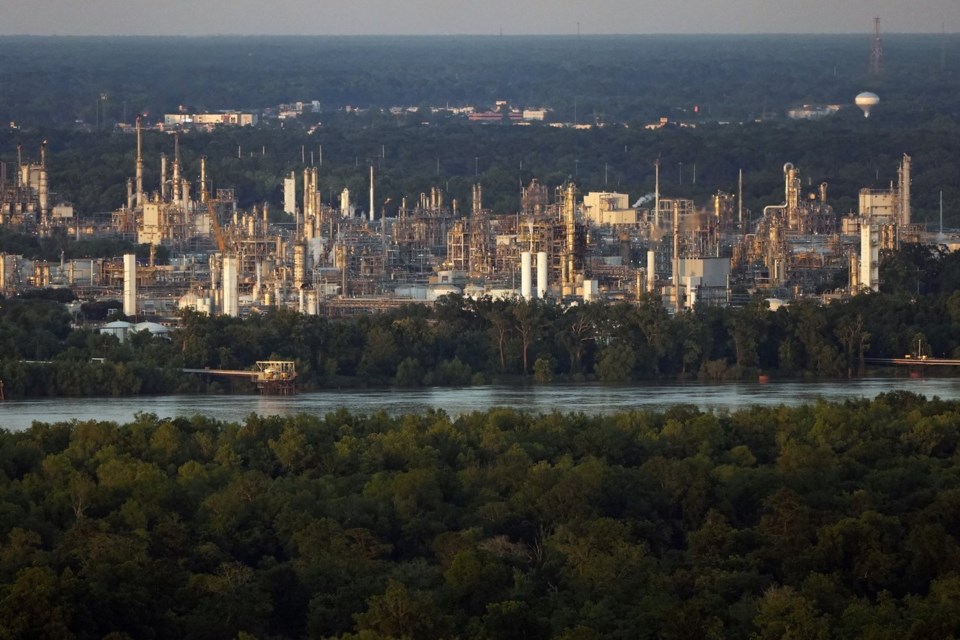NEW ORLEANS (AP) ŌĆö On days of heavy pollution in Sulphur, a southwest Louisiana town surrounded by more than 16 industrial plants, Cynthia ŌĆ£CindyŌĆØ Robertson once flew a red flag outside her home so her community knew they faced health hazards from high levels of soot and other pollutants.
But she stopped flying the flag after Louisiana passed a law last May that threatened fines of up to $1 million for sharing information about air quality that did not meet strict standards.
On Thursday, Robertson's group Micah 6:8 Mission and other Louisiana environmental organizations sued the state in federal court over the law they say restricts their free speech and undermines their ability to promote public health in .
When neighbors asked where the flags went, "IŌĆÖd tell them, ŌĆÖThe state of Louisiana says we canŌĆÖt tell yŌĆÖall that stuff,' ŌĆØ Robertson said.
While the state has argued the law ensures that accurate data is shared with the public, environmental groups like Micah 6:8 Mission believed it was intended to censor them with ŌĆ£onerous restrictionsŌĆØ and violates their free speech rights, according to the lawsuit.
Despite having received Environmental Protection Agency funding to monitor Sulphur's pollution using high quality air monitors for several years, Michah 6:8 Mission stopped posting data on the group's social media after the law was signed last May, Robertson said.
Residents living near plants seek data
While federal law requires publicly disclosed monitoring of major pollutants, fence-line communities in Louisiana have long sought data on their exposure to hazardous and likely carcinogenic chemicals like and , which were not subject to these same regulations.
Under the Biden administration, the EPA tightened regulations for these pollutants, though the Trump administration has committed to rolling them back.
The Biden administration's EPA also injected funding to support community-based air monitoring, especially in neighborhoods on the ŌĆ£fence-lineŌĆØ with industrial plants that emitted pollutants that they were not required to publicly monitor under federal law. Some groups say they lack confidence in the data the state does provide and embraced the chance to monitor the air themselves with federal funding.
ŌĆ£These programs help detect pollution levels in areas of the country not well served by traditional and costly air monitoring systems,ŌĆØ the lawsuit stated.
In response to the influx of grassroots air monitoring, Louisiana's Legislature passed the Community Air Monitoring Reliability Act, or CAMRA, which requires that community groups that monitor pollutants ŌĆ£for the purpose of alleging violations or noncomplianceŌĆØ of federal law must follow EPA standards, including approved equipment that can cost hundreds of thousands of dollars.
David Cresson, president and CEO of the Louisiana Chemical Association, said that the law is intended to clarify that ŌĆ£regulatory and legal decisionsŌĆØ should be made with ŌĆ£scientifically validated methods that meet established EPA standards.ŌĆØ
David Bookbinder, director of law and policy at the Environmental Integrity Project, which represents the plaintiffs, disagreed.
ŌĆ£You can't talk about air quality unless you're using the equipment that they want you to use,ŌĆØ said He added there was no need for community groups to purchase such expensive equipment when cheaper technology could provide ŌĆ£perfectly adequate results ... to be able to tell your community, your family, whether or not the air they're breathing is safe.ŌĆØ
While Cresson said community groups could still monitor air with equipment ŌĆ£not certified for regulatory useŌĆØ to raise awareness, environmental groups say the law makes any monitoring efforts vulnerable to litigation.
Community groups sharing information based on cheaper air monitoring equipment that did not meet these requirements could face penalties of $32,500 a day and up to $1 million for intentional violations, according to analysis from the Environmental Integrity Project.
Community groups fear a chilling effect from law
ŌĆ£WeŌĆÖre a small nonprofit, we couldnŌĆÖt afford to pay one day's worth of that,ŌĆØ Robertson said. "And the way the law is written, itŌĆÖs so ambiguous, you donŌĆÖt really know what you can and canŌĆÖt do."
There is no known instance in which the state has pursued these penalties, but community groups say the law has a chilling effect on their work.
ŌĆ£The purpose of this was very clear: to silence the science, preventing people from doing anything with it, sharing it in any form,ŌĆØ said Caitlion Hunter, director of research and policy for Rise St. James, one of the plaintiffs in the lawsuit.
ŌĆ£IŌĆÖm not sure how regulating community air monitoring programs ŌĆśviolates their constitutional rightsŌĆÖ,ŌĆØ Louisiana Attorney General Liz Murrill countered in a written statement.
ŌĆ£The goal of this law is not to silence community voices, but to ensure that regulatory action is based on high-quality, validated science,ŌĆØ Cresson said. ŌĆ£Community members are fully free to raise concerns, publish findings, and engage with the public or agencies to promote awareness.ŌĆØ
Industry groups are excluded from the law's requirements, the lawsuit notes.
The law presumes ŌĆ£that air monitoring information lacks accuracy if disseminated by community air monitoring groups, but not by industry participants or the state,ŌĆØ the complaint states.
The Louisiana Department of Environmental Quality and the Environmental Protection Agency declined to comment, citing pending litigation.
___
Brook is a corps member for The Associated Press/Report for America Statehouse News Initiative. is a nonprofit national service program that places journalists in local newsrooms to report on undercovered issues.
Jack Brook, The Associated Press




